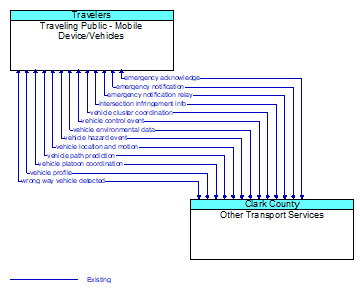Interface: Traveling Public - Mobile Device/Vehicles - Other Transport Services

Architecture Flow Definitions
emergency acknowledge (Existing)
Acknowledge request for emergency assistance and provide additional details regarding actions and verification requirements.
emergency notification (Existing)
An emergency request for assistance that is automatically initiated by a vehicle or manually initiated by a vehicle occupant. The request includes call–back number, date, time, location, pre–event vehicle heading, vehicle make, model, model year, and fuel type, and crash severity indicators. Crash severity indicators include: airbags deployed, number of impacts, crash delta velocity, principle direction of force, and rollover indication. In addition, seatbelt restraint use, number of occupants, occupant location, and intrusion may be included. For commercial vehicles, this flow may also include freight equipment type (box, flatbed, trailer, container, etc.), type of cargo (refrigerated, non–perishable, liquid, etc.), hazardous material data, quantity of cargo, and cargo permits as applicable (hazmat, special routing permissions).
emergency notification relay (Existing)
The relay of a previously received emergency notification. This relay enables a connected vehicle that is passing within radio range of a vehicle in need of assistance to store the notification and then forward it to a public safety agency when communications is available. Multiple relays may be necessary in remote areas with infrequent traffic and spotty communications coverage. The relay includes all of the information included in the original emergency notification (see 'emergency notification') and relay–specific data that can be used to manage the relay. Relay–specific data may include the date and time of original emergency notification receipt and the number of times the message has been relayed.
intersection infringement info (Existing)
Vehicle path information sent by a vehicle that is violating the stop bar at an intersection. This flow includes the vehicle's position, heading, speed, acceleration, transmission, steering–wheel angle, braking status, size information and trajectory.
vehicle cluster coordination (Existing)
Coordination between CACC–equipped vehicles that enable formation and management of strings of adjacent equipped vehicles that coordinate speed management across the string. This flow includes coordination between CACC–equipped vehicles that enable adjacent vehicles in the same lane to identify each other and couple. Depending on the CACC implementation, this flow also supports identification of the lead vehicle in the string, operating performance parameters for the string, destination information so that drivers can join strings that share their destination, and coordination so that strings of vehicles are ordered based on the individual weight and performance profile of each participating vehicle. This flow also supports dissolution of CACC vehicle strings as vehicles depart from the string.
vehicle control event (Existing)
Notification that the vehicle has performed an emergency action that could impact the safety of surrounding vehicles. This includes hard braking and activation of traction/stability control systems or other actions that warrant immediate notification of surrounding vehicles. The information flow conveys the vehicle's position, heading, speed, acceleration, transmission, steering wheel angle, braking status, size information, and trajectory.
vehicle environmental data (Existing)
Data from vehicle safety and convenience systems that can be used to estimate environmental and infrastructure conditions, including measured air temperature, exterior light status, wiper status, sun sensor status, rain sensor status, traction control status, anti–lock brake status, vertical acceleration and other collected vehicle system status and sensor information. The collected data is reported along with the location, heading, and time that the data was collected. Both current data and snapshots of recent events (e.g., traction control or anti–lock brake system activations) may be reported.
vehicle hazard event (Existing)
Notification of a potential hazard that is detected by the vehicle, including hazards posed by the vehicle itself. Self–reported hazards include notification that the vehicle is being operated in an unsafe manner or is stopped in the travel lanes or on the shoulder. Detected hazards include unequipped vehicles operating unsafely, traffic queues, and foreign objects (people, animals, debris, other obstacles) in the travel lanes. It includes vehicle location and status, path, current control actions, and additional information on the detected hazard, if applicable.
vehicle location and motion (Existing)
Data describing the vehicle's position, heading, speed, acceleration, transmission, steering wheel angle, braking status, size information, and trajectory.
vehicle path prediction (Existing)
The predicted future vehicle path of travel. This flow includes an indication of the future positions of the transmitting vehicle that can be used by receiving vehicles to support coordinated driving manuevers and enhance in–lane and out–of–lane threat classification.
vehicle platoon coordination (Existing)
Coordination of control commands between leader and follower vehicles allowing vehicles to join, coordinate with, and separate from platoons of cooperative vehicles. This flow shares platoon size, location, and performance parameters (e.g., platoon speed and spacing) between platooned vehicles. It also coordinates maneuvers between platooned vehicles, including maneuvers as vehicles join and leave the platoon.
vehicle profile (Existing)
Information about a vehicle such as vehicle make and model, fuel type, engine type, size and weight, vehicle performance and level of control automation, average emissions, average fuel consumption, passenger occupancy, or other data that can be used to classify vehicle eligibility for access to specific lanes, road segments, or regions or participation in cooperative vehicle control applications.
wrong way vehicle detected (Existing)
Notification that a vehicle has been detected traveling in the wrong direction. This can be a direct report by an equipped vehicle that is being driven in the wrong direction or a report of a non–equipped vehicle that has been detected traveling in the wrong direction. It includes the current location, speed, acceleration, and heading of the wrong way vehicle.